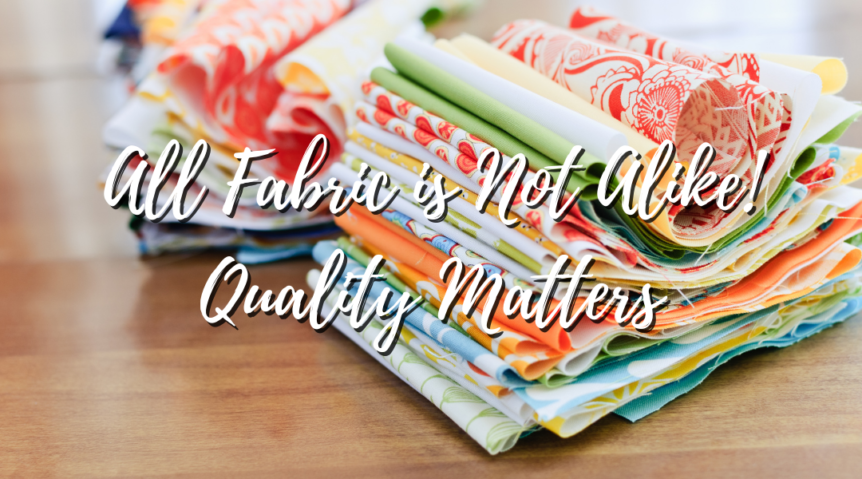The Different Types of Fabric
First, “fabric” is a material made by entwining fibers together. Generally, a fabric is named after the fiber user to manufacture it; some fabrics will even blend different fibers. The fabric is then named depending on the fiber(s) used, its pattern and texture and the production process implemented. Some fabrics also consider where the fibers originated from.
Based on this, two sets of categories separate the fabric types: the fibers used (natural vs. synthetic) and the production processes (woven vs. knitted).
Natural vs. Synthetic
The first differing detail with fabrics depends on what type of fiber is used. There are two types: natural and synthetic. Natural fibers are obtained from plants and animals. For example, cotton comes from plants, while silk comes from silkworms. On the other hand, synthetic fibers are made entirely of synthetic matter created by man.
Woven vs. Knitted
The second differing detail is the production process used. Again, there are two types: woven and knitted. Woven fabrics comprise two pieces of yarn interweaving horizontally and vertically on a loom. Since the yarn runs at a 45-degree angle, the fabric doesn’t stretch and is usually tauter and sturdier than knit fabrics. The fabric consists of a weft (when the yarn goes across the width of the fabric) and a warp (when the yarn goes down the length of the loom). There are three types of woven fabric: plain weave, satin weave and twill weave. Popular woven fabrics include chiffon, crepe, denim, linen, satin and silk.
For knit fabric, think of a hand-knit scar; the yarn is formed into an interconnecting loop design, which allows it to stretch significantly. Knit fabrics are known for being elastic and keeping shape. There are two types of knit fabric: warp-knitted and weft-knitted. Examples of popular knit fabrics are lace, lycra and mesh.
Fabric Types and Descriptions
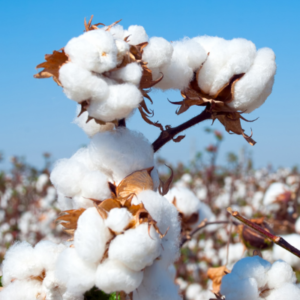 Cotton is the most popular material in the world. Cotton is a light, soft natural fabric. The fluffy fiber is extracted from the seeds of the cotton plant in a process called ginning. The fiber is then spun into cloth, which can be woven or knit. This fabric is praised for its comfortableness, versatility and durability. It is hypoallergenic and breathes well, though it doesn’t dry quickly. Cotton can be found in virtually any type of clothing: shirts, dresses, and underwear. However, it can wrinkle and shrink. Cotton yields many types of additional fabrics, including chino, chintz, gingham and muslin. For quilting, high-quality, 100% cotton is preferred for the front and back of quilts and the batting (or wadding) used to create a “quilt sandwich.” Batting is available as 100% cotton, a cotton/poly blend, wool, bamboo/cotton/silk blend and more.
Cotton is the most popular material in the world. Cotton is a light, soft natural fabric. The fluffy fiber is extracted from the seeds of the cotton plant in a process called ginning. The fiber is then spun into cloth, which can be woven or knit. This fabric is praised for its comfortableness, versatility and durability. It is hypoallergenic and breathes well, though it doesn’t dry quickly. Cotton can be found in virtually any type of clothing: shirts, dresses, and underwear. However, it can wrinkle and shrink. Cotton yields many types of additional fabrics, including chino, chintz, gingham and muslin. For quilting, high-quality, 100% cotton is preferred for the front and back of quilts and the batting (or wadding) used to create a “quilt sandwich.” Batting is available as 100% cotton, a cotton/poly blend, wool, bamboo/cotton/silk blend and more.
I bought some black and white 100% cotton Mickey Mouse fabric at Walmart a few years ago because my grandson was obsessed with Mickey Mouse, and I wanted to make him a Mickey-themed quilt. I bought a yard of cardboard-like fabric as I did not find enough other higher-quality prints for the quilt. I vividly remember trying to work with that fabric; it was a headache. The difference in quality between the Mickey prints that Walmart sold and the gorgeous Mickey fabric made by Springs Creative purchased from a local quilt store was night and day.
When you’re in a physical store shopping for fabric and need to question the quality, take a corner of the material and crumple it in your hands. Hold it there for 15-20 seconds, then release the fabric. Does the fabric stay hopelessly crumpled or slowly regain shape with minimal wrinkling? A good quality fabric will retain its original shape after this test.
Next, does the fabric have a distinct (odd) or chemical smell? Odor signals the material has been chemically treated with stabilizers or sizing to make it appear heavier and more stable. After this type of fabric is laundered, it will likely need starch or sizing to look good. I always steer clear of any fabric with a funky smell as I have no way of knowing if the smell will go away after laundering.
With cotton, linen and other woven fabrics, thread count matters. Thread count (or the number of woven threads per square inch) is typically on the label of bed sheet packaging. Place a spot of the fabric between your thumb and index finger and rub the two back and forth together. Check the area. Do the fabric fibers appear to be separating? Do the fabric fibers appear to be twisted or pulled thin? If you answer “yes,” the fabric has a lower thread count and is not considered quality quilting fabric. It’s a yes for Halloween costumes and dog beds but could be better for quilting or home décor projects. Lower-quality fabric is typically more thinly woven than higher-quality fabric.
Unroll at least half a yard and look at the images printed on the fabric. Do they appear to be crisp and aligned? If you see “ghosting,” or where you can see a shadow slightly away from the printed image, it means it has been printed “out of registration.” A good manufacturer ensures all images are perfectly aligned. Often a company will sell goods out of registration as seconds or thirds to a company that offers them at discounts to fabric merchants.
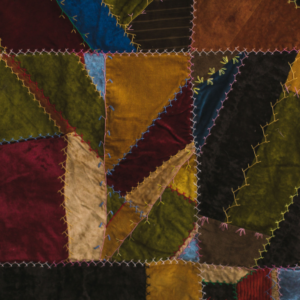 Crazy quilts were typically made from a wide variety of fabric scraps left over from garment sewing, draperies, upholstery and more. The word “crazy” conjures many meanings—erratic, jumbled, insane, bizarre—which at first makes sense when looking at the random patches of a late 1800s crazy quilt. Irregular shapes, haphazard fabrics, and meticulous embroidery compose these beautifully busy works. In truth, crazy quilts are far from erratic. These one-of-a-kind treasures are intentional statements reflecting a turning point in American history. Historians are not sure of crazy quilts’ precise beginnings, but they do agree that their popularity soared in the last quarter of the 1800s, becoming icons of the Victorian era.
Crazy quilts were typically made from a wide variety of fabric scraps left over from garment sewing, draperies, upholstery and more. The word “crazy” conjures many meanings—erratic, jumbled, insane, bizarre—which at first makes sense when looking at the random patches of a late 1800s crazy quilt. Irregular shapes, haphazard fabrics, and meticulous embroidery compose these beautifully busy works. In truth, crazy quilts are far from erratic. These one-of-a-kind treasures are intentional statements reflecting a turning point in American history. Historians are not sure of crazy quilts’ precise beginnings, but they do agree that their popularity soared in the last quarter of the 1800s, becoming icons of the Victorian era.
Philadelphia’s 1876 Centennial Exposition is also considered a dynamic influence in crazy-quilt design. At the entrance to the most popular Japanese Pavilion, the image of a priest on a paved road introduced the concept of asymmetry to more than ten million people who attended. A cracked-ice, mosaic pattern on the path as well as other unfamiliar art forms—with images of storks, owls, fans, and flowers—were exotic attractions for Americans. They had become enchanted with anything Oriental and were replicating the look in their art, including quilts, dinnerware, furniture, and other decorations.
Here’s more information about the types of fabric available today.
When it comes to fabric quality, there are many variables to consider. It’s important to understand the differences in fabric types and quality so that your projects have a great outcome. Whether you’re making apparel, quilts or everything for a nursery, it’s important to know each fabric type’s benefits and best uses.
Fabric types include cotton, linen, rayon, outdoor with UV treatment, cork, wool, chenille, damask, corduroy, muslin, taffeta, organza, chiffon, poplin, crepe, brocade, silk, satin, lycra, mesh, lace, leather, georgette, velvet and probably a few more that I’ve missed. These options are either woven or knitted, natural or synthetic. These options are made from 100% cotton, 100% polyester, poly/cotton blends, tri-blends of polyester/cotton/Tencel, polyester/spandex (polyurethane), silk, linen (flax), man-made synthetics, hemp, jute, bamboo, animal skins (leather) and more.
To help with some of this fabric confusion and create a better understanding of fabric, let’s take a look at several different types of fabric. Please remember that there are hundreds of different fabric types; this article is simply looking at the most popular types.
 Wool is a natural fiber from sheep, goat, llama or alpaca fleece. It can be knitted or woven. Wool is often noted for being hairy and itchy, though it keeps the body warm and is durable and long-lasting. It is also wrinkle-free and resistant to dust and wear and tear. This fabric can be a bit expensive, as it needs to be hand-washed or dry-cleaned. Wool is mostly used in sweaters, socks, gloves and in quilting, for decorative applique projects. Types of wool include tweed, Cheviot fabric, cashmere and Merino wool; Cheviot fabric is made from Cheviot sheep, cashmere is made from cashmere and pashmina goats and Merino wool is made from Merino sheep.
Wool is a natural fiber from sheep, goat, llama or alpaca fleece. It can be knitted or woven. Wool is often noted for being hairy and itchy, though it keeps the body warm and is durable and long-lasting. It is also wrinkle-free and resistant to dust and wear and tear. This fabric can be a bit expensive, as it needs to be hand-washed or dry-cleaned. Wool is mostly used in sweaters, socks, gloves and in quilting, for decorative applique projects. Types of wool include tweed, Cheviot fabric, cashmere and Merino wool; Cheviot fabric is made from Cheviot sheep, cashmere is made from cashmere and pashmina goats and Merino wool is made from Merino sheep.
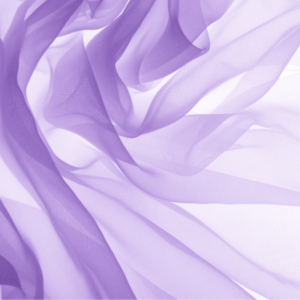 Chiffon is a sheer, lightweight, plain-woven fabric made from twisted yarn that gives it a slightly rough feel. The yarn is usually made of silk, nylon, polyester or rayon. Chiffon can be easily dyed and is usually seen in scarves, blouses and dresses, including wedding gowns and prom dresses, due to its light, flowing material.
Chiffon is a sheer, lightweight, plain-woven fabric made from twisted yarn that gives it a slightly rough feel. The yarn is usually made of silk, nylon, polyester or rayon. Chiffon can be easily dyed and is usually seen in scarves, blouses and dresses, including wedding gowns and prom dresses, due to its light, flowing material.
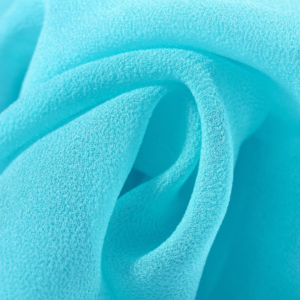 Crepe is a lightweight, twisted plain-woven fabric with a rough, bumpy surface that doesn’t wrinkle. It is often made from cotton, silk, wool or synthetic fibers, making it a versatile fabric. Due to this, crepe is usually called after its fiber; for example, crepe silk or crepe chiffon. Crepe is often used in suit and dressmaking since it’s soft, comfortable and easy to work with. For example, georgette is a type of crepe fabric often used in designer clothes. Crepe is also used in blouses, pants, scarves, shirts and skirts.
Crepe is a lightweight, twisted plain-woven fabric with a rough, bumpy surface that doesn’t wrinkle. It is often made from cotton, silk, wool or synthetic fibers, making it a versatile fabric. Due to this, crepe is usually called after its fiber; for example, crepe silk or crepe chiffon. Crepe is often used in suit and dressmaking since it’s soft, comfortable and easy to work with. For example, georgette is a type of crepe fabric often used in designer clothes. Crepe is also used in blouses, pants, scarves, shirts and skirts.
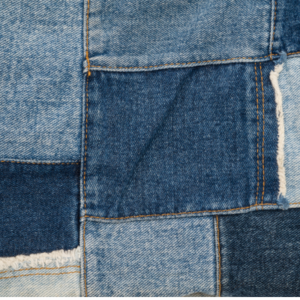 Denim is a woven cotton twill fabric made from entwined cotton wrap yarn and white cotton stuffing yarn. It is often known for its vivid texture, sturdiness, durability and comfortableness. Denim is mostly dyed with indigo to create blue jeans, but it is also used for jackets and dresses. Many people repurpose denim to make quilts, purses and more.
Denim is a woven cotton twill fabric made from entwined cotton wrap yarn and white cotton stuffing yarn. It is often known for its vivid texture, sturdiness, durability and comfortableness. Denim is mostly dyed with indigo to create blue jeans, but it is also used for jackets and dresses. Many people repurpose denim to make quilts, purses and more.
 Lace is an elegant, delicate fabric made from looped, twisted or knitted yarn or thread. It was originally made from silk and linen, but lace is now made with cotton thread, wool or synthetic fibers. There are two main elements to lace: the design and the ground fabric, which holds the pattern together. Lace is considered a luxury textile, as it takes time and expertise to create the open-weave design and web-like pattern. The soft, transparent fabric is often used to accent or embellish clothing, especially with bridal gowns and veils, though it can be found in shirts and nightgowns.
Lace is an elegant, delicate fabric made from looped, twisted or knitted yarn or thread. It was originally made from silk and linen, but lace is now made with cotton thread, wool or synthetic fibers. There are two main elements to lace: the design and the ground fabric, which holds the pattern together. Lace is considered a luxury textile, as it takes time and expertise to create the open-weave design and web-like pattern. The soft, transparent fabric is often used to accent or embellish clothing, especially with bridal gowns and veils, though it can be found in shirts and nightgowns.
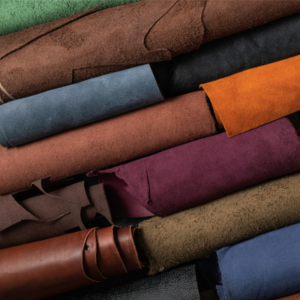 Leather is a unique type of fabric in that it is made from animal hides or skins, including cows, crocodiles, pigs and lamb. Depending on the animal used, leather will require different treatment techniques. Leather is known for being durable, wrinkle-resistant and stylish. Suede is a type of leather (usually made from lamb) that has the “flesh side” turned outward and brushed to create a soft, velvety surface. Leather and suede are often found in jackets, shoes and belts since the material keeps the body warm in cold weather.
Leather is a unique type of fabric in that it is made from animal hides or skins, including cows, crocodiles, pigs and lamb. Depending on the animal used, leather will require different treatment techniques. Leather is known for being durable, wrinkle-resistant and stylish. Suede is a type of leather (usually made from lamb) that has the “flesh side” turned outward and brushed to create a soft, velvety surface. Leather and suede are often found in jackets, shoes and belts since the material keeps the body warm in cold weather.
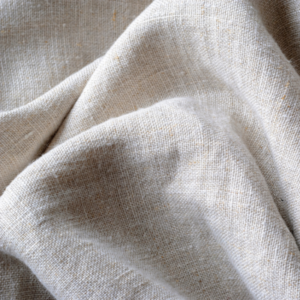 Linen is one of the oldest materials known to humankind. Made from natural fibers, this strong, lightweight fabric comes from the flax plant, which is stronger than cotton. The flax strands are spun into yarn, which is then blended with other fibers. Linen is absorbent, cool, smooth and durable. It is machine-washable, but it needs regular ironing, as it creases easily. Though it can be used in clothing, including suits, jackets, dresses, blouses and trousers, linen is mostly used in drapes, tablecloths, bedsheets, napkins and towels.
Linen is one of the oldest materials known to humankind. Made from natural fibers, this strong, lightweight fabric comes from the flax plant, which is stronger than cotton. The flax strands are spun into yarn, which is then blended with other fibers. Linen is absorbent, cool, smooth and durable. It is machine-washable, but it needs regular ironing, as it creases easily. Though it can be used in clothing, including suits, jackets, dresses, blouses and trousers, linen is mostly used in drapes, tablecloths, bedsheets, napkins and towels.
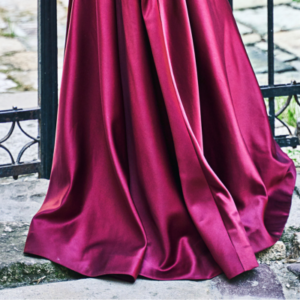 Satin, unlike most of the fabrics on this list, is not made from a fiber; it is actually one of the three major textile weaves and is made when every strand is well-knitted. Satin was originally made from silk and is now made from polyester, wool and cotton. This luxurious fabric is glossy, elegant and slippery on one side and matte on the other. Noted for its sleek, smooth surface and lightweight, satin is often used in evening and wedding gowns, lingerie, corsets, blouses, skirts, coats, outerwear and shoes. It can also be used as a backing to other fabrics.
Satin, unlike most of the fabrics on this list, is not made from a fiber; it is actually one of the three major textile weaves and is made when every strand is well-knitted. Satin was originally made from silk and is now made from polyester, wool and cotton. This luxurious fabric is glossy, elegant and slippery on one side and matte on the other. Noted for its sleek, smooth surface and lightweight, satin is often used in evening and wedding gowns, lingerie, corsets, blouses, skirts, coats, outerwear and shoes. It can also be used as a backing to other fabrics.
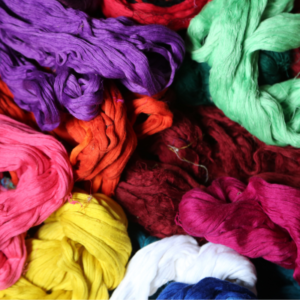 Silk is known as the world’s most luxurious natural fabric in the world, It is a soft, elegant fabric choice with a smooth touch and shimmering look. Silk comes from the silkworm’s cocoon, which are found in China, South Asia and Europe. It is the most hypoallergenic, durable, strongest natural fabric, though it is difficult to clean and delicate to handle; many fabric weaves tighten or pucker when washed, so it’s best to hand wash or dry clean silk. Like lace, satin is expensive due to the time-consuming, delicate process or turning the silk thread into yarn. Silk is mostly used in wedding and evening gowns, shirts, suits, skirts, lingerie, ties and scarves. The two most popular types are Shantung and Kashmir silk.
Silk is known as the world’s most luxurious natural fabric in the world, It is a soft, elegant fabric choice with a smooth touch and shimmering look. Silk comes from the silkworm’s cocoon, which are found in China, South Asia and Europe. It is the most hypoallergenic, durable, strongest natural fabric, though it is difficult to clean and delicate to handle; many fabric weaves tighten or pucker when washed, so it’s best to hand wash or dry clean silk. Like lace, satin is expensive due to the time-consuming, delicate process or turning the silk thread into yarn. Silk is mostly used in wedding and evening gowns, shirts, suits, skirts, lingerie, ties and scarves. The two most popular types are Shantung and Kashmir silk.
 Velvet has been associated with royalty, luxury and glamour due to its soft, luxurious, rich, opulent finishing and complex production process. This heavy, shiny woven warp pile fabric has a smooth pile effect on one side. The textile’s quality is determined by the pile tuft’s density and the way they are anchored to the base fabric. Velvet can be made from cotton, linen, cool, silk, nylon or polyester, making it a versatile material that is either inelastic or stretchy. It is often used in blouses, shirts, coats, skirts, evening wear and outerwear.
Velvet has been associated with royalty, luxury and glamour due to its soft, luxurious, rich, opulent finishing and complex production process. This heavy, shiny woven warp pile fabric has a smooth pile effect on one side. The textile’s quality is determined by the pile tuft’s density and the way they are anchored to the base fabric. Velvet can be made from cotton, linen, cool, silk, nylon or polyester, making it a versatile material that is either inelastic or stretchy. It is often used in blouses, shirts, coats, skirts, evening wear and outerwear.
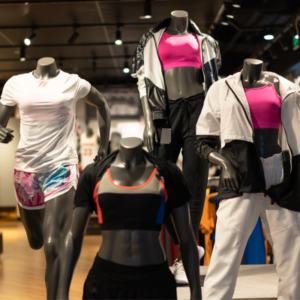 Unlike the other fabrics listed here, synthetics actually cover several fabric types: nylon, polyester, spandex and fleece. Synthetics don’t shrink, unlike delicate fabrics, and are usually resistant to water-based stains. Nylon is a completely synthetic fiber made up of polymers. It is known for its strength, flexibility and resilience. Nylon is also long-lasting and handles wear and tear, which is why it is often seen ins outerwear, including jackets and parkas. Polyester is a man-made synthetic fiber and fabric created from petrochemicals. Though it is strong, durable and wrinkle and stain-resistant, polyester is not breathable and doesn’t absorb liquids well. Instead, it is designed to move moisture away from the body. Most T-shirts, trousers, skirts and sportswear are made from polyester. Arguably the most popular synthetic material is spandex, which is made from polyurethane. Also known as Lycra or elastane, spandex is known for its lightweight, elasticity and strength after being blended with several fiber types. This comfortable, form-fitting material is often used in jeans, hosiery, dresses, sportswear and swimwear.
Unlike the other fabrics listed here, synthetics actually cover several fabric types: nylon, polyester, spandex and fleece. Synthetics don’t shrink, unlike delicate fabrics, and are usually resistant to water-based stains. Nylon is a completely synthetic fiber made up of polymers. It is known for its strength, flexibility and resilience. Nylon is also long-lasting and handles wear and tear, which is why it is often seen ins outerwear, including jackets and parkas. Polyester is a man-made synthetic fiber and fabric created from petrochemicals. Though it is strong, durable and wrinkle and stain-resistant, polyester is not breathable and doesn’t absorb liquids well. Instead, it is designed to move moisture away from the body. Most T-shirts, trousers, skirts and sportswear are made from polyester. Arguably the most popular synthetic material is spandex, which is made from polyurethane. Also known as Lycra or elastane, spandex is known for its lightweight, elasticity and strength after being blended with several fiber types. This comfortable, form-fitting material is often used in jeans, hosiery, dresses, sportswear and swimwear.
Will you use garment or other fabric to make a “crazy” quilt? I think I’m going to stick to top-quality quilting cotton!
Happy sewing!
Dianne

